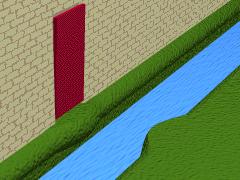drawbridge

A drawbridge (also: drawbridge ) is a movable bridge, which can be folded up with the aid of a mechanical device in order to control access to a target or to allow the passage of ships on a waterway. The movable part of the bridge, known as the bridge flap, rotates around a horizontal axis of rotation or around a hinge . The bridge is pulled up with ropes or chains that attach to the outer end of the bridge flap. Most of the time the drawbridge led over a moat, which was sometimes filled with water.
Drawbridges in defense construction

Drawbridges were used to secure a gate in medieval castles and city fortifications, as well as in many modern fortresses . Drawbridges have been handed down from the High Middle Ages, but were not more widespread in German-speaking countries until the late Middle Ages.
The gate was a particular weak point in castles and similar defensive structures and was therefore often protected by various structural devices. With the help of a drawbridge in front of the gate, the access via the moat could be effectively and quickly interrupted. While fixed wooden bridges were also built for this purpose, which could be removed in the event of a siege, the drawbridge allowed more flexible control over access and could also be used for rapid breakdowns . The bridge hatch provided additional protection for the gate opening when pulled up. To prevent attackers from pulling down the bridge hatch with hooks, a recess in the wall was often created around the gate, into which the bridge could hit flush.
Two different basic constructions for the winding mechanism were common in medieval drawbridges:
- Chain or rope bridge. With this design, two parallel ropes or chains lead from the outer end of the bridge plate in a diagonal line through two wall openings above the gate into the interior of the gatehouse, where they can be hauled in with a winch . To make it easier to pull up, counterweights can be attached to the end of the chains or to an extension of the bridge track behind the axis of rotation.
- Swing rod bridge. This construction makes use of the leverage effect in that the chains are attached to two so-called swing rods or see-saw beams , which run parallel to the bridge flap and are continued inside the gatehouse behind the pivot axis. The rear halves of the swing rods are connected to each other by a stable frame construction on which additional counterweights can be attached. The bridge is raised by moving the rear end of the swing rods down.
Drawbridge with diagonally guided chains and Counterweight, sectional drawing by Viollet-le-Duc
A scene from the Siege of Champtoceaux ( 1420 ) in an illumination by Pierre Le Baud . On the left you can see the citadel of the city with the drawbridge lowered. The wooden construction on the wall above are the swing rods with their frame construction.
Drawbridges in hydraulic engineering

In hydraulic engineering , drawbridges are used to enable ships to pass through a canal if the mast or chimney of the ship extends beyond the level of the bridge runway. Usually two drawbridges facing each other are built for this purpose, which, when folded up, allow passage through the middle of the canal. The bridges usually have swing rods (see above). Various other movable bridge constructions, for example bascule bridges or lift bridges, also fulfill the same purpose . In the Rotterdam district of Schiedam there is a wooden drawbridge that still has to be operated with a hand crank. Another example of a manual and functional folding mechanism is the Wiecker bridge in Greifswald .
literature
- Christofer Herrmann: portcullis and drawbridges. In: Joachim Zeune (ed.): "Dem Feind zum Trutz". Defense elements on medieval castles (= publications of the German Burgenvereinigung eV, series B: Writings. Volume 14). German Castle Association, Braubach 2015, ISBN 978-3-927558-38-0 , pp. 153–158 ( digitized version ).
Web links
Individual evidence
- ↑ Rudolf Huber, Renate Rieth: Castles and fixed places. The defense construction before the introduction of firearms. Tübingen 1977 (Glossarium Artis), pp. 66-75.


